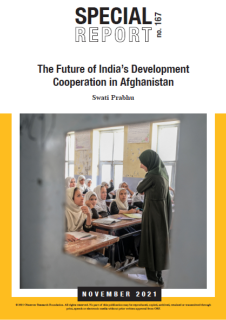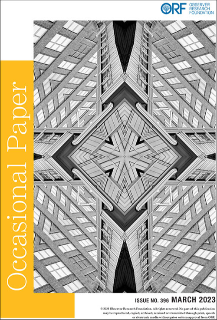Results of the 2004 parliamentary elections have generated a serious debate among scholars and analysts following the unexpected ouster of the Bharatiya Janata Party (BJP)-led National Democratic Alliance (NDA) and the victory of the Congress-led coalition. Some see it as "the revenge of the poor against the pro-rich image of the government" and there are many who ascribe this to "the supposed maturity and ingenuity of the India voter". There are some others who characterize Verdict 2004 as a "protest against the high-voltage India Shining campaign of the NDA".
This general election was distinct from previous elections in the sense that, after long time, a national election was not fought on any emotive issue. As a result, the usual caste, class, region and other primordial considerations influenced the electoral choice of the voters, in varying intensity from state to state. Past voting patterns show that Indian voters respond collectively only when there are emotive national issues. The BJP was the worst loser of this trend. An analysis of the BJP's past electoral performance successes would explain it quite clearly. Its entry rise into the corridors of power was largely because it successfully raised highly controversial and emotive issues such as the construction of the Ram temple in Ayodhya. With a mere two seats in the Lok Sabha in 1985, it could bag a whopping 85 seats in 1989 and by 1996 it had surpassed the Congress and emerged as the majority party in Parliament by playing the Ayodhya card. A pointer to this is the case of the BJP winning 57 seats in Uttar Pradesh on the Ayodhya plank in 1996 with religious fervour overshadowing caste, class and party considerations. Alter, in the 1999 elections, it reaped a good electoral harvest by projecting India's success in the Kargil War as monumental achievement of the Vajpayee government.
In 2004, the party, however, departed from its earlier tactics of bringing emotive issues to the fore and decided to seek a pro-incumbency verdict through showcasing the booming economy in the from of 'Feel Good Factor' and 'Indian Shining' campaigns. Thus, good governance and development became its new slogans, particularly in the light of its electoral success in three major northern Indian states in November 2003. Although the India Shining campaign generated huge interest initially, its impact was largely confined to urban pockets. Even the NDA's fervent attempt to turn the contest as one between an Indian-born Vajpayee and a foreign born Sonia Gandhi had a limited impact, in the face of mundane issues dominating in varying degree the electoral scene in most of the states. Thus, regional and sectarian issues played a crucial role in determining the fate of th4 contestants. Those who had a better grip over caste, class and religious arithmetic eventually won; such a trend is clearly visible in UP and Bihar. Regional and caste based parties like the Samajwadi Party (SP) and Bahujan Samaj Party (BSP) secured maximum electoral gains at the cost of the BJP and the Congress.
The bigger picture that emerges from the results of the elections is that in the absence of emotive national issues, voters responded to local issues with incumbent governments being at the receiving end, and the BJP suffered most. For example in 1999, Chandrababu Naidu could win the elections by sewing up a clever alliance with a rising BJP in Andhra Pradesh (AP) and profiting from India's success in the Kargil War. This time round, his hope to profit from the India Shining campaign and the Atal wave did not pay any dividends as the campaign lost its flavour half way with more serious, pressing local issues dominating the voter's choice. Even his track record as an efficient Chief Minister, a strong record of good governance and his efforts to give a new vision to AP did not help him. His party's complete rout both in the Legislative Assembly and Lok Sabha elections is good evidence. Similarly, in Tamil Nadu, the All India Anna Dravida Munnetra Kazhagam (AIDMK) that swept the Assembly elections in 2001 drew a blank this time, largely because of the poor performance of the state government, a strong anti-incumbency mood and the formidable alliance led by the DMK. Perhaps, the presence of an emotive issue could have saved the AIDMK from total rout. In fact, despite the incumbency disadvantage in 1999, the DMK could bag a good number of seats largely because of its alliance with the BJP. At the time, the BJP was riding after the country's victory in the Kargil War. Electoral results in these two states made all the difference in the 2004 elections as the BJP lost more than 70 seats here.
Despite local issued dominating the elections, the NDA would still have emerged victorious had it not gambled in choosing new political allies. In fact, the BJP's rise to power in the past has been as much to its ability to rake up emotional issues as to the wise selection of allies. The BJP as a national party had its own reasons to be averse to coalition politics, but with the increasing realization that its vote base did not extend beyond the northern belt, it had to tie up with regional parties. Besides, it desperately sought to erase the untouchable tag of 1996, when its 13-day government failed in 1996 to muster the support of even one political party. Later, because of its conscious efforts like offering a Common Minimum Programmes (CMP) to the allies, the BJP could secure the support of 23 political parties and for the government in 1998. Moreover, the BJP's success in the 1999 general elections was largely a result of the practical alliances it forged with regional parties. Resultantly, its total tally crossed 300. This time around, the BJP sensed it all wrong in the euphoria of overwhelming victory in the Assembly elections to three states and a buoyant economy. It failed to read correctly that the message in the three states was anti-incumbency mood there than the impression that voters approved the development plank of the party. The feeling that the Indian voter had matured to support a positive and pro-incumbency government blinded the strategists of the party who ignored the criticality of alliances in a country where sectarian issues often guide voters' choice. The assumption that they would be able to cross the magic number of 273 with a few allies was a seminal blunder. As a result of this buoyant feeling, it allowed the DMK to slip from its fold, chose to go it alone in Haryana, and spurned the Assam Gana Parishad and the NCP's overtures on seat sharing in Maharashtra. True, even with the support of all these parties it may not yet have secured a majority, as the election outcome shows, but it would have easily crossed the 200 mark to remain in the reckoning.
The BJP's loss was Congress's gain. The Congress, the biggest critic of coalition politics, that chose to fight elections in 1996, 1998 and 1999 on the stability plank took a smart U-turn this time by forging desperate but tactical alliances with parties of every hue. It forged crucial and timely alliance with the DMK, the party it hated the most for its alleged involvement in Rajiv Gandhi's assassination and pulled down I.K. Gujral's government, joined hands with Laloo Prasad Yadav in Bihar settling for just four seats, made an alliance with the Telengana Rasthra Samiti agreeing to support it on separate statehood, and tied up with the Jharkhand Mukti Morcha. Besides, it went along with NCP overlooking Sharad Pawar's objection to Sonia Gandhi's foreign origin issue. Eventually, it won 145 seats on its own and the allies brought in a sizeable 71 seats. Besides, its tactical support and seat adjustment with the Left parties in some states like A.P helped those parties to record their highest ever tally and lend crucial support to the Congress to form the government at the center. The BJP, although it could secure 138 seats, seven less than the Congress, was in no position to form the government as its allies won only 48 seats against a mammoth 119 in 1999.
In short, the reasons for the NDA's poll debacle are complex and too many but mainly due to its clinical failure to feel a simmering anti-incumbency wave in the euphoria of victory in the three major northern India states, last minute hara-kiri in alliances and more importantly because the voters decided on local issues than on national issues. Further, Verdict 2004 should be judged from the point of the voter's judgment of the performance of the respective state governments in addressing their daily needs than what was thought to be on the persuasive development plank of the NDA. The electorate largely responded to the issues of primordial concerns irrespective of the party they voted for.
The results of the 2004 elections can at best be called fractured. It would be a tall claim to make that the verdict was in favour of the Congress and its allies. How else does one explain its complete rout in Kerala, Punjab, Karnataka, M.P., Rajasthan, Chattisgarh and Orissa? The Congress has been lucky its allies delivered at a crucial time.
Email ID :
[email protected] * Views expressed in this article are those of the author and do not necessarily reflect those of Observer Research Foundation.
The views expressed above belong to the author(s). ORF research and analyses now available on Telegram! Click here to access our curated content — blogs, longforms and interviews.




 PREV
PREV


